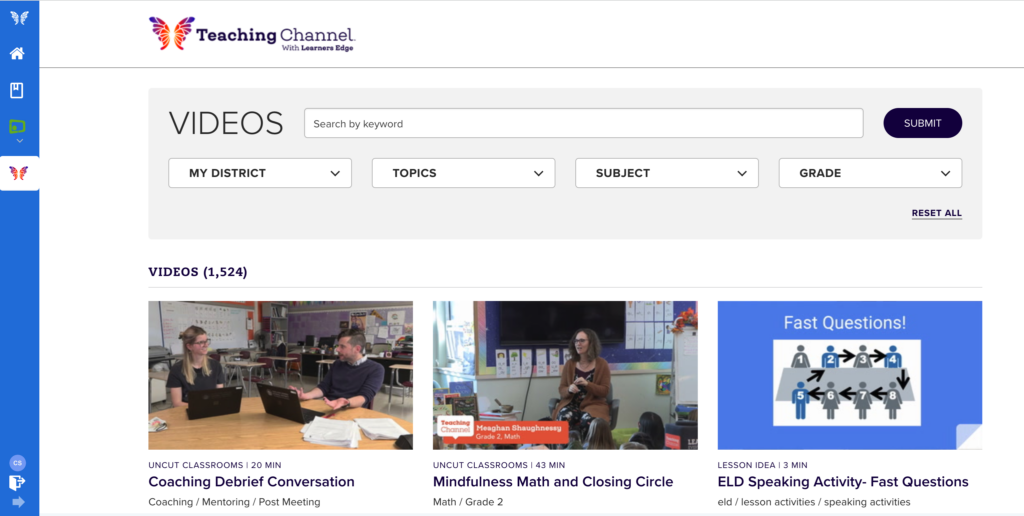As educators, we often say to ourselves and others, “We have to improve student performance.” Our students deserve the best that we have to offer; this is where it begins and ends! The truth is if we are not growing professionally, then our impact on student outcomes will be limited. Adopting a mindset that we can all improve our practice sets the foundation for student success–but taking actual steps to improve is the key. Utilizing video for self-reflection and instructional coaching support are two steps in the right direction.
In a time when our learning environments oscillate from virtual or remote to in-person settings, the need for professional growth remains. The pandemic has opened our eyes to the need to connect with others — video provides the conduit to building a networked improvement community (NIC) focused on growing better together.
Over the last three and a half years, Marion County School District (SC), Colonial School District (DE), Metropolitan School District of Decatur Township (IN), and Gainesville ISD (TX) have worked to build a tight-knit networked improvement community. To learn more about their work, download this research brief.
This year, two more districts have joined the NIC: Guilford Public Schools (CT) and Mansfield Public Schools (CT). Below are five key reasons for why and how this six-district, five-state NIC thrives because of the benefits of video coaching.

#1. Elevate the focus on growth and reflection by developing a collective “why.”
If the goal is to truly develop a NIC where video is utilized for self-reflection and growth, we must be intentional about developing and communicating the purpose. It should be used for growth and reflection — not evaluation. Consider engaging key stakeholders in outlining the purpose for video coaching.
Dr. Annine Crystal, assistant superintendent of curriculum and instruction for Guilford Public Schools, discusses the benefits of video coaching.
“We had a new coach video herself meeting with two teachers to reflect on the use of an instructional technique she was supporting. This was done through the Teaching Channel Platform. When she watched herself on video, she saw multiple issues she wanted to address so she reached out to a veteran coach who also watched the video and then asked clarifying questions, and pushed the new coach’s thinking around facilitation techniques. After she had shared with her veteran colleague, the new coach then shared the video with me asking for my thoughts, and then reflected on the experience of actually facilitating the meeting as well as the experience of debriefing the video with a colleague. There was a great deal of growth and reflection evident in this new coach’s conversation with me as a result of the multiple layers of video analysis.”

Principal, Adam Allen, of MSD Decatur in Indiana shares how video coaching has helped to create a safe space for his teachers to grow.
“We have used video coaching in our PLCs for teachers to reflect on their teaching of Text Evidence and Inferencing. They were able to analyze their own instruction/modeling and identify success criteria for the standard they were teaching. This enabled us to break down each element of the lesson to identify where we can improve. This was done in a non-evaluative way and it created an intellectually safe community where teachers could learn, grow and reflect on their own lesson as well as provide feedback on their colleagues’ videos in PLCs.”
#2. Align the use of video to district- or school-level goals and priorities–and to individual professional goals–to give purpose to the work.
Having an intentional purpose for video–whether it’s district oriented or an individual’s desire to improve a specific instructional skill–elevates the relevancy for the educator. Additionally, aligning the use of video to district or school goals and priorities connects the dots for educators, thus removing the silo effect.
Mike Seal, a principal at the Mansfield School District in Connecticut, is integrating video to have teachers briefly write comments on the rigor and relevance of the task; using rubrics the district has developed through their work with Authentic Intellectual Work (AIW), and to then have a virtual dialogue about the rigor and relevance of the task.
Karen Klein, a lead teacher in MSD Decatur, has teachers submit videos via the Teaching Channel Platform every quarter and receive feedback on their own personal goals. This initiates an instructional and professional growth coaching conversation and a way to reflect and improve practice.
#3. Establish an “all means all” philosophy.
Effective leaders are the “first learners.” They lead by example and go first. As the organization develops its systematic plan and process for utilizing video coaching, it will be important that district and school leaders engage in the process of recording and reflecting on elements of their own practice in a transparent manner before asking teachers to record, self-reflect and then share videos for feedback and coaching.
Superintendent of Guilford Public Schools in Connecticut, Paul Freeman, shares the importance of confident vulnerability when it comes to video.
“If a principal is confident enough to capture themselves on video, watch that video, share that video with a peer, and ultimately share that video with me so that I can look at it and we can then talk about the performance, that almost guarantees the kind of confident vulnerability and growth mindset that we’re looking to support in every learner in the district–from the students in the classroom to every member of the leadership team.”

#4. Build a community of practice by developing reflective practitioners.
Video allows us to see and self-reflect on the impact our practice has on our audience. Read on as three educators share how video is providing new opportunities for their educators.
“Video gives us the opportunity to stop and think about what we could have done better or what we will do in the future to enhance our lessons or meetings.” -Kiara Jenkins, a lead teacher and STEP (Supporting Teacher Effectiveness Project) facilitator of Marion County School District in South Carolina.
“Teachers have been able to share targeted instructional videos with each other, supporting one another with positive feedback and gaining ideas to improve writing instruction.” – Principal, Emily LeMay, of MSD Decatur, Indiana.
“Teachers submit videos through the Teaching Channel Platform where they are able to ask for feedback on a very specific segment or teaching practice. This enables coaches to support teachers with laser-focused coaching.” – Hannah Karl, lead teacher of MSD Decatur.
#5. Offer support.
By nature, educators seek to engage in the behaviors and actions that will support student success. However, on occasion, the questions can arise about what the next steps should be. Offer suggestions, examples, and models for how video can be utilized to improve performance. Video can be leveraged as a method for calibration of coaching conversations, delivery of instruction, facilitation of professional development, and facilitation of Instructional Leadership Team meetings.
In Marion County School District, superintendent Dr. Kandace Bethea, encourages the Instructional Leadership Teams (ILT) in each of her schools to utilize video to calibrate on both in-person and virtual instruction. The ILTs use the state-level teaching standards as the framework on which they anchor their conversations.
Kristina Criswell, a lead teacher at MSD Decatur describes how they are utilizing the Teaching Channel Platform for their video coaching efforts.
“We have also utilized the Teaching Channel Platform videos for coaching calibration in ILTs. This is much needed in ILT so that we are all are speaking the same language and are consistent with our feedback.”
In highly successful networked improvement communities, video is utilized as a means for self-reflection, coaching, and calibrating around effective instructional practice. When we take the next step to apply what we have learned about our practice, we see improvements in student performance. The commitment of the NIC to the use of video via the Teaching Channel Platform elevates the belief that we can truly grow better together.







